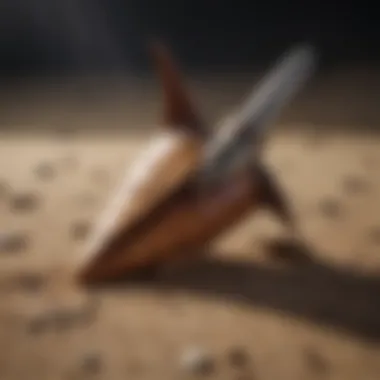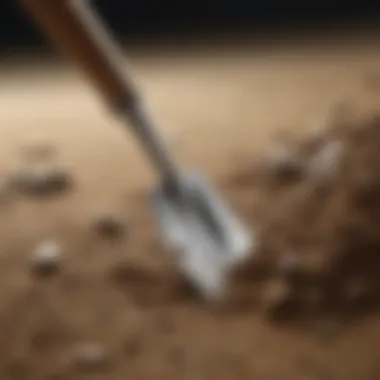Unveiling the Fascinating World of Shark Tooth Hunting Tools


Rock and Fossil Identification
In the realm of shark tooth hunting, a crucial aspect lies in the identification of rocks and fossils. Enthusiasts must familiarize themselves with various types of rocks and fossils to enhance their search for these prehistoric treasures. When embarking on a fossil-hunting expedition, it is essential to recognize the distinct characteristics that differentiate different specimens. By honing the skill of identifying rocks and fossils, collectors can streamline their search process and increase their chances of discovering rare and valuable finds. Utilizing tools specifically designed for rock and fossil identification can also significantly aid in this endeavor.
Collecting Tips and Techniques
To excel in shark tooth hunting, collectors must adopt effective collecting tips and techniques. Best practices involve conducting thorough research on prime collecting sites distinguished for their rich fossil content. Locating these sites can greatly heighten the likelihood of unearthing exceptional specimens. Additionally, learning how to safely extract fossils from their surrounding rock formations is paramount to preserving their integrity and value. Implementing the correct techniques ensures that specimens are retrieved without damage or alteration, allowing collectors to build a remarkable collection over time.
Preservation and Display
Once collectors have obtained shark teeth and other fossils, preserving them becomes a critical consideration. Various preservation techniques can be employed to maintain the integrity and aesthetics of the specimens. Proper storage methods, such as using acid-free containers and protective padding, help prevent deterioration and safeguard against environmental factors. Furthermore, creative display ideas enhance the visual appeal of the collection, making it an impressive showcase of prehistoric marvels. By mastering preservation and display techniques, collectors can safeguard their precious finds for future enjoyment and education.
Geological Insights
Delving deeper into the world of shark tooth hunting unveils fascinating geological insights. Understanding the geological formations and processes that contributed to the creation of these fossils adds layers of appreciation for their historical significance. Rocks and fossils tell stories of the Earth's past, offering valuable insights into ancient ecosystems and evolutionary processes. Learning about notable discoveries in the field of paleontology provides further enrichment, allowing collectors to connect with the broader scientific community and contribute to ongoing research efforts.
Introduction
In the fascinating realm of shark tooth hunting, the importance of having the right tools cannot be overstated. These tools are not just accessories but critical components that determine the success of collectors in their quest for these prized fossils. As enthusiasts delve into the world of shark tooth hunting, understanding the tools of the trade is essential for maximizing their hunting experience and ensuring they come away with valuable finds. This section will shed light on the key aspects of shark tooth hunting tools, exploring their significance and how they contribute to the success of collectors.
Understanding Shark Tooth Hunting
Brief History of Shark Tooth Hunting
Shark tooth hunting has a rich and intriguing history that dates back centuries. The journey of early explorers and collectors in search of these elusive treasures has paved the way for modern-day enthusiasts. Understanding the roots of shark tooth hunting not only provides insight into its evolution but also highlights the enduring allure of these fossilized shark teeth. The historical significance of shark tooth hunting is not just a matter of pastime but a gateway to unraveling the mysteries of prehistoric oceans.
Significance of Shark Teeth in Paleontology
Beyond being mere artifacts, shark teeth hold immense scientific value in paleontology. These fossilized teeth offer a glimpse into the ancient marine ecosystems, providing researchers with valuable insights into the biodiversity of past oceans. The significance of shark teeth in paleontology lies in their ability to help reconstruct the evolutionary history of sharks and other marine species. By studying these teeth, scientists can piece together the puzzle of Earth's prehistoric marine life, making shark tooth hunting a vital endeavor in the field of paleontology.
Tools of the Trade
Essential Shark Tooth Hunting Tools


At the core of every shark tooth hunter's gear are essential tools that form the foundation of their collection efforts. Tools such as trowels, hand trowels, and bulb diggers are indispensable for excavating and uncovering shark teeth from fossil-rich sites. These tools not only aid in the extraction process but also ensure the careful handling of delicate fossils, preserving them for further study and display. The role of essential shark tooth hunting tools goes beyond mere instruments—they are extensions of the collector's passion and dedication to uncovering the secrets of the past.
Specialized Equipment for Advanced Collectors
For seasoned collectors looking to elevate their hunting game, specialized equipment offers advanced functionality and precision in fossil recovery. Water sifting tools like floating sifters and underwater scoops enable collectors to sift through sediment-rich waters with ease, increasing their chances of finding rare and elusive shark teeth. Specialized digging tools such as small picks and long-handle shovels provide enhanced reach and maneuverability in challenging excavation sites, allowing collectors to access hidden fossil deposits with accuracy and efficiency. High-end identification devices like UV lights and polarizing microscopes further enhance the collector's ability to identify and examine fossil specimens with unparalleled detail and clarity, making them indispensable tools for advanced hunters.
Choosing the Right Equipment
Factors to Consider in Selecting Shark Tooth Hunting Tools
When embarking on a shark tooth hunting expedition, selecting the right tools is a crucial decision that can make or break the success of the venture. Factors such as the geological composition of the hunting site, the type of shark teeth being targeted, and the collector's experience level all play a role in determining the most suitable tools for the job. By taking these factors into account, collectors can ensure they have the right equipment to maximize their chances of making significant fossil discoveries.
Tips for Beginners in Tool Selection
For beginners venturing into the world of shark tooth hunting, navigating the wide array of tools available can be overwhelming. From selecting the right trowel to choosing the ideal sifting screen, beginners can benefit from expert tips that guide them in making informed equipment choices. Factors such as affordability, durability, and ease of use are crucial considerations for novice collectors looking to build their tool kit. By following these tips and recommendations, beginners can set themselves up for a rewarding and successful shark tooth hunting experience.
Essential Shark Tooth Hunting Tools
In the captivating world of shark tooth hunting, the use of essential tools is paramount in ensuring a successful and fulfilling experience for enthusiasts. These tools are not just instruments but companions on the journey to uncovering rare and prized fossils. Each tool serves a specific purpose, catering to different aspects of the hunting process, ultimately contributing to the thrill of discovery and the preservation of these prehistoric treasures.
Digging Tools
Trowels
Trowels are indispensable when it comes to delicately excavating and unearthing shark teeth from various terrains. Their sharp, pointed blades allow collectors to carefully dig around specimens without causing damage. The ergonomic design of trowels makes them comfortable to handle for extended periods, crucial during long hours of hunting. Their durability and precise cutting edge make them a popular choice among shark tooth hunters, enabling them to extract fossils with accuracy and finesse.
Hand Trowels
Hand trowels, smaller in size compared to traditional trowels, offer versatility in reaching tight or compact spaces where larger tools may not fit. Their compact nature allows for precision digging, especially in rocky or hard soil conditions. Additionally, hand trowels are lightweight and easily portable, making them convenient for fieldwork. Despite their smaller stature, hand trowels are robust and effective in delicately excavating shark teeth, making them a valuable addition to a collector's toolkit.
Bulb Diggers
Bulb diggers excel in penetrating deep into the ground to extract buried treasures with minimal disruption to the surrounding area. Their elongated, cylindrical shape aids in creating clean, cylindrical holes, ideal for precise excavation. This specialized tool is favored for its ability to retrieve specimens hidden beneath layers of soil or gravel efficiently. While bulb diggers offer excellent depth capabilities, they may require more effort to operate compared to other digging tools due to their focused digging function.
Screening Tools


Sifting Screens
Sifting screens play a crucial role in the shark tooth hunting process by allowing collectors to sift through collected sediments efficiently. These mesh screens help separate fossils from debris, streamlining the cleaning and sorting process. The lightweight and portable nature of sifting screens make them essential for on-site use, enabling hunters to examine sifted materials promptly. Despite their simplicity, sifting screens are indispensable for ensuring no precious finds are overlooked during the hunting expedition.
Classifiers
Classifiers aid in categorizing and refining the materials extracted during a hunt, allowing collectors to differentiate between various sediment sizes and compositions. By using classifiers, enthusiasts can segregate finer particles from larger debris, facilitating a more systematic examination of potential shark tooth specimens. The versatility of classifiers lies in their ability to enhance the precision of the sorting process, offering a meticulous approach to identifying and preserving fossils effectively.
Storage and Identification Tools
Magnifying Glass
Magnifying glasses are essential for examining the intricate details of shark teeth, allowing collectors to observe minute features that may determine the specimen's species or origin. The magnification provided by these tools enhances the overall hunting experience by enabling enthusiasts to appreciate the intricacies of each find. Compact and easy to carry, magnifying glasses are indispensable for field identification, providing a closer look at fossil characteristics that may escape the naked eye.
Measuring Tools
Measuring tools are vital for recording the size and dimensions of shark teeth accurately, essential for scientific research and documentation. By using measuring tools such as calipers or rulers, collectors can establish precise measurements of specimens, contributing to the overall understanding of prehistoric fauna. These tools ensure consistency in size documentation, aiding in the classification and comparison of shark teeth within an avid collector's catalogue.
Advanced Equipment for Seasoned Collectors
When it comes to shark tooth hunting, seasoned collectors understand the value of advanced equipment in enhancing their expeditions. Advanced equipment offers increased efficiency and precision, allowing collectors to uncover rare finds with greater ease. These tools cater to the specific needs of experienced individuals who are well-versed in the art of shark tooth hunting. From water sifting tools to specialized digging equipment, seasoned collectors rely on these advanced tools to elevate their hunting experience, making the process more productive and rewarding.
Water Sifting Tools
Water sifting tools are essential for collectors who engage in underwater or beachside hunting expeditions. They aid in the separation of sediment and debris, allowing collectors to sift through sand and gravel more effectively. Floating sifters, a key component of water sifting tools, are designed to float on the water's surface, enabling collectors to sift through large volumes of material efficiently. Their lightweight and buoyant nature make them convenient and easy to maneuver, particularly in aquatic environments. Despite their versatility, floating sifters may have limitations in handling heavier or denser sediments, requiring collectors to consider the specific conditions of their hunting grounds.
Underwater scoops are another integral part of water sifting tools, specially crafted for retrieving items from underwater locations. They feature durable materials and efficient designs to withstand underwater pressures and facilitate the retrieval of artifacts. Their unique structure allows collectors to scoop up sand and other materials while underwater, aiding in the exploration of submerged areas. However, underwater scoops may have limited reach or capacity, depending on their design, requiring collectors to adapt their techniques accordingly to maximize their effectiveness.
Specialized Digging Tools
Specialized digging tools cater to the specific needs of seasoned collectors, offering precision and durability in excavation activities. Small picks are a popular choice among collectors due to their versatility and maneuverability. They enable targeted digging in confined spaces, allowing collectors to extract fossils with precision and care. The pointed tips of small picks provide control and accuracy in excavation, minimizing the risk of damage to delicate specimens. While small picks excel in detailed probing and extraction, they may require additional effort for digging in harder sediment layers, necessitating collectors to apply varying levels of force.
Long-handle shovels are indispensable for collectors engaged in extensive excavation projects or searching in larger areas. Their extended handles provide leverage and reach, reducing strain on collectors during prolonged digging sessions. Long-handle shovels are designed for efficiency and comfort, enabling collectors to cover more ground and excavate larger sections with ease. However, their size and weight may present challenges in maneuverability and precision, requiring collectors to balance strength and control when using them.


High-End Identification Devices
High-end identification devices play a crucial role in the exploration and analysis of collected specimens, offering enhanced vision and clarity in observation. UV lights serve as essential tools for detecting fluorescence in fossilized materials, aiding in the identification of unique characteristics and markings. Their ultraviolet wavelengths illuminate hidden details that are not visible to the naked eye, providing collectors with valuable insights into the composition and authenticity of their finds. Despite their efficacy in revealing fluorescent properties, UV lights may have limitations in differentiating certain materials or colors, necessitating collectors to use them in conjunction with other identification methods.
Polarizing microscopes are precision instruments that enable collectors to explore the intricate structures of fossils and minerals with high magnification. They offer advanced imaging capabilities and enhanced contrast, allowing collectors to examine specimens at a microscopic level. Polarizing microscopes enhance the viewing experience by polarizing light sources, minimizing glare and reflections for clearer observation. While polarizing microscopes excel in detailed analysis and observation, their intricate mechanics and higher costs may pose challenges for beginners or casual collectors, requiring a certain level of expertise and investment in maintenance and operation.
Maintenance and Care of Tools
In this article exploring the world of shark tooth hunting tools, delving into the crucial aspect of Maintenance and Care of Tools is paramount. Providing insight into the significance of preserving and maintaining these tools enhances their longevity and effectiveness. By highlighting the importance of proper maintenance practices, enthusiasts can optimize their equipment's performance and prolong its lifespan. Ensuring the care and upkeep of tools is essential for a successful and fruitful shark tooth hunting expedition.
Cleaning and Storage
Proper Cleaning Techniques
Proper Cleaning Techniques are pivotal in ensuring the longevity and efficiency of shark tooth hunting tools. Utilizing specific cleaning methods tailored to different materials prevents corrosion and maintains optimal functionality. The meticulous cleaning process involves removing dirt, debris, and residues to prevent damage and deterioration. Enthusiasts benefit greatly from incorporating Proper Cleaning Techniques into their routine, as it ensures the tools remain in pristine condition, ready for future use. This choice is favored in the article for its emphasis on preservation and performance enhancement.
Storage Tips for Prolonged Use
Storage Tips for Prolonged Use are vital for maintaining the integrity of shark tooth hunting tools during periods of non-use. Proper storage prevents rust, corrosion, or any form of degradation that may affect the equipment's effectiveness. Key characteristics of effective storage include keeping tools in a dry, secure environment to avoid exposure to moisture or extreme temperatures. The uniqueness of Storage Tips lies in its ability to safeguard tools for long-term use, offering enthusiasts peace of mind and ensuring their equipment remains in top-notch condition for future expeditions.
Tool Maintenance
Sharpening Blades
Sharpening Blades is a crucial aspect of tool maintenance that directly impacts performance and efficiency. Ensuring the blades are sharp enhances cutting precision and effectiveness during excavation, making the process smoother and more efficient. The key characteristic of this practice is its ability to maintain the sharpness and durability of blades, prolonging their lifespan and optimizing their functionality. Sharpening Blades is a popular choice in this article due to its substantial contribution to maximizing tool performance and overall effectiveness.
Preventative Maintenance Practices
Preventative Maintenance Practices involve proactive steps taken to prevent potential issues and ensure the longevity of shark tooth hunting tools. Conducting regular inspections, lubrications, and adjustments can preemptively address wear and tear, prolonging the tools' usability. The unique feature of Preventative Maintenance Practices is their ability to identify and resolve small problems before they escalate, saving time and resources in the long run. Emphasizing these practices in the article underscores the significance of preventive care in maintaining tools at their peak performance level.
Conclusion
Enhancing Your Shark Tooth Hunting Experience
Utilizing the Right Tools for Success
Delving into the specific aspect of utilizing the right tools for success, it becomes apparent that the key characteristic lies in matching the tools to the specific terrain and conditions of the hunting site. This tailored approach ensures that collectors can extract fossils efficiently without causing damage or missing potential finds. The unique feature of this practice is its adaptability to diverse environments, making it a versatile and essential choice for enthusiasts seeking to optimize their hunting expeditions. While the advantage of utilizing the right tools is clear in increased productivity and accuracy, potential disadvantages may include the cost of acquiring specialized equipment or the need for extensive research to determine the most suitable tools for each location.
Continual Learning and Improvement
Continual learning and improvement play a pivotal role in the evolution of a shark tooth hunter's skillset. The key characteristic here is the willingness to adapt techniques based on ongoing experiences and feedback, fostering growth and proficiency in fossil collection. This dedication to self-improvement is a popular choice for enthusiasts looking to refine their methods and expand their knowledge in the field. The unique feature of continual learning and improvement is its long-term benefits, as it allows collectors to stay current with advancements in technology and paleontological practices. While the advantages of this mindset are clear in honing expertise and expanding horizons, potential disadvantages may include the time and effort required to stay informed and adapt to new methodologies.







